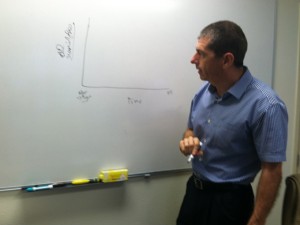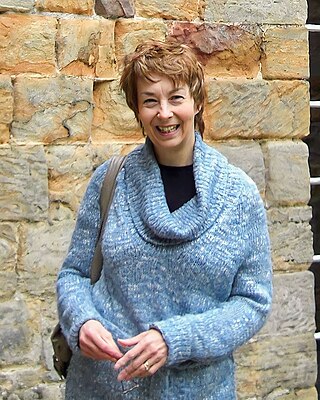
Amyloid plaques are extracellular deposits of the amyloid beta (Aβ) protein mainly in the grey matter of the brain. Degenerative neuronal elements and an abundance of microglia and astrocytes can be associated with amyloid plaques. Some plaques occur in the brain as a result of aging, but large numbers of plaques and neurofibrillary tangles are characteristic features of Alzheimer's disease. The plaques are highly variable in shape and size; in tissue sections immunostained for Aβ, they comprise a log-normal size distribution curve, with an average plaque area of 400-450 square micrometers (μm2). The smallest plaques, which often consist of diffuse deposits of Aβ, are particularly numerous. Plaques form when Aβ misfolds and aggregates into oligomers and longer polymers, the latter of which are characteristic of amyloid.

A neurodegenerative disease is caused by the progressive loss of neurons, in the process known as neurodegeneration. Neuronal damage may also ultimately result in their death. Neurodegenerative diseases include amyotrophic lateral sclerosis, multiple sclerosis, Parkinson's disease, Alzheimer's disease, Huntington's disease, multiple system atrophy, tauopathies, and prion diseases. Neurodegeneration can be found in the brain at many different levels of neuronal circuitry, ranging from molecular to systemic.Because there is no known way to reverse the progressive degeneration of neurons, these diseases are considered to be incurable; however research has shown that the two major contributing factors to neurodegeneration are oxidative stress and inflammation. Biomedical research has revealed many similarities between these diseases at the subcellular level, including atypical protein assemblies and induced cell death. These similarities suggest that therapeutic advances against one neurodegenerative disease might ameliorate other diseases as well.
Karen K. Hsiao Ashe is a professor at the Department of Neurology and Neuroscience at the University of Minnesota (UMN) Medical School, where she holds the Edmund Wallace and Anne Marie Tulloch Chairs in Neurology and Neuroscience. She is the founding director of the N. Bud Grossman Center for Memory Research and Care, and her specific research interest is memory loss resulting from Alzheimer's disease and related dementias. Her research has included the development of an animal model of Alzheimer's.

VIB is a research institute located in Flanders, Belgium. It was founded by the Flemish government in 1995, and became a full-fledged institute on 1 January 1996. The main objective of VIB is to strengthen the excellence of Flemish life sciences research and to turn the results into new economic growth. VIB spends almost 80% of its budget on research activities, while almost 12% is spent on technology transfer activities and stimulating the creation of new businesses, in addition VIB spends approximately 2% on socio-economic activities. VIB is member of EU-LIFE, an alliance of leading life sciences research centres in Europe.
Sir John Anthony Hardy is a human geneticist and molecular biologist at the Reta Lila Weston Institute of Neurological Studies at University College London with research interests in neurological diseases.
Bart De Strooper is a Belgian molecular biologist and professor at Vlaams Instituut voor Biotechnologie and KU Leuven and the UK Dementia Research Institute and University College London, UK. De Strooper's research seeks to translate genetic data into the identification and treatment of neurodegenerative diseases and treatments. interest are the secretases, proteases which cleave the amyloid precursor protein (APP), resulting in amyloid peptides.

Michael Mullan is an English-American researcher in Alzheimer's disease and related neurodegenerative disorders. Mullan was a co-discoverer of genetic causes of Alzheimer's disease. Subsequently, he was a co-inventor on the original patents that covered three mutations in the amyloid precursor protein (APP) gene, a gene which is linked to familial Alzheimer's disease. He also co-authored articles in Nature and Nature Genetics, describing these three genetic errors; he was the senior author on two of those articles. Dr. Mullan co-discovered a specific genetic mutation, which became known as "the Swedish Mutation," because it was originally identified in DNA samples from two Swedish families whose members often developed early-onset Alzheimer's disease. These human genetic mutations were integrated into mouse DNA to create strains of mice that are being used worldwide to develop new drug treatments for Alzheimer's disease.

Presenilin-2 is a protein that is encoded by the PSEN2 gene.
Jurgen Del-Favero is a Belgian scientist working at the VIB Department of Molecular Genetics at the University of Antwerp. His research is directed towards the identification of susceptibility genes for psychiatric disorders and tools for DNA sequence research. His research, in collaboration with the Swedish research group under the direction of Rolf Adolfsson, indicated that the TPH2 protein is involved in the development of depression and manic depression.
Vincent Timmerman is a Belgian scientist working at the VIB Department of Molecular Genetics at the University of Antwerp of Christine Van Broeckhoven. His research is focused on inherited disorders of the peripheral nervous system, classified as hereditary motor and/or sensory neuropathies and the most common inherited peripheral neuropathy is Charcot-Marie-Tooth (CMT) disease or Hereditary Motor and Sensory Neuropathy (HMSN).

Early-onset Alzheimer's disease (EOAD), also called younger-onset Alzheimer's disease (YOAD), is Alzheimer's disease diagnosed before the age of 65. It is an uncommon form of Alzheimer's, accounting for only 5–10% of all Alzheimer's cases. About 60% have a positive family history of Alzheimer's and 13% of them are inherited in an autosomal dominant manner. Most cases of early-onset Alzheimer's share the same traits as the "late-onset" form and are not caused by known genetic mutations. Little is understood about how it starts.
Peter Henry St George-Hyslop, OC, FRS, FRSC, FRCPC, is a British and Canadian medical scientist, neurologist and molecular geneticist who is known for his research into neurodegenerative diseases. St George-Hyslop is one of the most cited authors in the field of Alzheimer's disease research. He has identified a number of key genes that are responsible for nerve cell degeneration and early-onset forms of Alzheimer's disease. These include the discovery of the presenilins, Nicastrin, TREM2, Apolipoprotein E and SORL1 genes. Presenilin mutations are the most common cause of familial Alzheimer's disease. St George-Hyslop also co-led the discovery of the gene for the amyloid precursor protein.

Rudolph Emile 'Rudy' Tanzi a professor of Neurology at Harvard University, vice-chair of neurology, director of the Genetics and Aging Research Unit, and co-director of the Henry and Allison McCance Center for Brain Health at Massachusetts General Hospital (MGH).
Konrad Beyreuther is a German molecular biologist and chemist known for his work on neurodegenerative diseases.
Alison Mary Goate is the Jean C. and James W. Crystal Professor and Chair of the Department of Genetics and Genomic Sciences and Director of the Loeb Center for Alzheimer's Disease at Icahn School of Medicine at Mount Sinai, New York City. She was previously professor of genetics in psychiatry, professor of genetics, and professor of neurology at Washington University School of Medicine.

Urtė Neniškytė is a Lithuanian neuroscientist. Her scientific interest and main area of work relates to the interaction of neurons and immune cells in the brain. She has studied the cellular mechanisms of Alzheimer's disease and is the co-author of the first articles about cell death in relation to phagocytosis.
Lary Walker is an American neuroscientist and researcher at Emory University in Atlanta, Georgia. He is Associate Director of the Goizueta Alzheimer's Disease Research Center at Emory, and he is known for his research on the role of abnormal proteins in the causation of Alzheimer's disease.

Martin Neil Rossor is a British clinical neurologist with a specialty interest in degenerative dementias and familial disease.
Dennis J. Selkoe is an American physician (neurologist) known for his research into the molecular basis of Alzheimer's disease. In 1985 he became Co-Director of the Center for Neurological Diseases and from 1990, Vincent and Stella Coates Professor of Neurological Diseases at Harvard Medical School. He is also a Fellow of the AAAS and a member of the National Academy of Medicine.

Carol Joyce Jennings was a British campaigner and advocate for research into Alzheimer's Disease. She served as an honorary Vice-President of the Alzheimer's Society until her death in 2024. Through her activism in the 1980s, Jennings brought her family to the attention of researchers studying the disease, which subsequently led to the discovery of the London Mutation. This mutation, found on the Amyloid Precursor Protein (APP) gene located on chromosome 21, marked a significant breakthrough in understanding the genetic basis of Alzheimer's Disease and provided evidence for the development of the 'amyloid hypothesis', which attempts to explain the underlying causes of Alzheimer's Disease.









